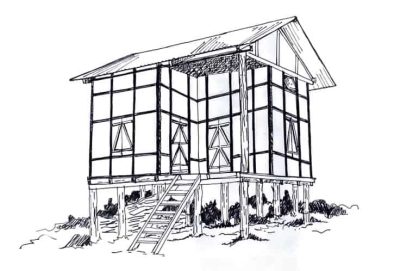The Mask of Tradition – The Influence of Modernity on Traditional Indian Architecture
Traditional architecture is crucial in adapting to geographical conditions. However, modern materials have become a more popular choice for the masses. According to Farha Shermin and Mainak Gosh, lacking a thorough understanding of both types has led to a confusing typology.
Traditional architecture constitutes the base of a surrounding’s identity. It connects us to the past and serves as a very essential source of knowledge. Beyond its aesthetic value, it provides a unique and irreplaceable record of intangible heritage.
India is a country with diverse geographic, climatic, and socio-cultural conditions. Therefore, each region is recognisable by its own individual architectural characteristics.
Different forms of traditional buildings characterise India’s architectural landscape. It is essential to notice a particular architectural style that is derived in a specific region by blending local resources, traditions, and climate responsiveness into the buildings.
Traditional Architecture in Assam
The North-Eastern state of Assam in India is known for its unique kind of architecture, which is characterised by using locally available and natural materials like bamboo, wood, and mud, among others. The use of these materials along with sensible design not only makes the traditional architecture sustainable but also shows great respect to the existing micro-climate. It is sensitive to natural calamities, including earthquakes and floods which Assam is extremely prone to.

A traditional Assam-type single-story house in Guwahati, Assam © Farha Shermin
Geographically the region is a combination of both plains and hills, which makes it abundant in natural resources. Its humid subtropical climate is characterised by hot and humid summers, severe monsoons, and moderate winters. Along with the geographical diversity, cultural variety in Assam has also played a significant role in shaping its traditional architecture.
Adapting to Geographical Conditions
The British colonial style has influenced the tradition, which combines the use of bricks, wood, stone, and rock slabs. As the region of Assam is susceptible to heavy rainfall, sloping roofs and high plinths are common architectural features in almost all structures.
In general, traditional houses in Assam are single or double-story houses with a raised plinth – a kind of base – to avoid marshy grounds and run-off during heavy rains. Some houses are also built on stilts termed ‘Chang Ghor’ and are usually found in flood-prone areas. The stilt level is also used as storage or to accommodate cattle.

A typical traditional ‘Chang Ghor’ (House on Stilts) © Farha Shermin
These houses are built using wood or bamboo as a framework and a locally found kind of reed termed as ‘Ikra’ is used extensively on wall panels. These are then plastered with a mixture of mud and dung. The sloping roofs are covered with thatch or metal sheets.
The Present Scenario: Less Tradition, Keeping Up with Trends
In recent decades a rapid transformation of the built environment could be observed. People are more and more physically and socially connected to the outside world and houses built today differ radically from traditional homes in many ways, ranging from material and structure to style and appearance.
Due to foreign influences and global modernisation, traditional houses built in most areas of Assam are becoming less influenced by existing traditions and more influenced by popular trends.
There is a desire to be called ‘modern’ and to keep up with the trends while at the same time there is a tendency to hold on to tradition. This has led to an approach which reduces and sometimes entirely ignores its social, cultural, and environmental as well as architectural values. Most of the time such houses mimic a traditional form but fail to attain other aspects of the traditional construction which were responsible for that form in the first place.
Modern Materials – an Obvious Choice For the Masses

A contemporary house mimicking the form of a ‘Chang Ghor’ © Farha Shermin
Materials like cement, steel, and glass are not only considered trendy but have also become a symbol of status among the masses. The materials are easily available, and so is skilled labour for the use of those materials and methods of construction. Hence, leaning towards modern materials becomes an obvious choice.
Incorporating Traditional Values Instead of Mimicking Foreign Styles
However, the issue does not concern the use of modern materials but the tendency to cater to both tradition and modernism without thoroughly understanding the characteristics of either.
Architecture is a cultural artefact – it cannot be understood without its cultural context. Hence, the traditional architecture of Assam is closely associated with its socio-cultural values. When new houses are designed and built, it is crucial to consider those values and incorporate those in architectural design instead of mimicking foreign styles.
